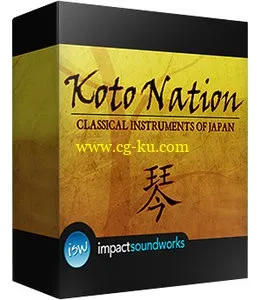
密码: ejxp
Impact Soundworks Koto Nation KONTAKT | 3.82 Gb
We created Koto Nation out of a desire to see traditional Japanese instruments receive a deep, thorough sampling treatment, much like our acclaimed North Indian sample library Sitar Nation. While there are a handful of libraries which include samples of the koto and shamisen, they feature only the most basic articulations and few (if any) velocities or round robins. To our knowledge, the bass koto has never been sampled at all! Given the popularity of the shakuhachi and taiko in many Western film soundtracks, we wanted to allow film composers, hobbyist producers, ethnomusicologists, anime fans and everyone in between access to these classic instruments and complete the repertoire of traditional Japanese sounds available.
Koto
The national instrument of Japan, and one of the oldest stringed instruments in the world! The koto has 13 strings with an equal number of movable bridges allowing the player to adjust tuning, something that is often called for in pieces. It is traditionally played using three finger picks used to pluck the strings, but a variety of other techniques have developed as well such as finger tapping, harmonics, pizzicato, etc.
Bass Koto
Developed in the early 20th century, the bass koto is a much larger version of the standard koto which adds 4 additional strings and allows for much lower pitches to be played. Its deep, warm sound and large range has made it popular in some forms of Japanese traditional music as well as contemporary music.
Shamisen
Like the koto, this three-stringed developed centuries ago and became an integral part of Japanese music, perhaps most associated with its role in traditional theater where it is still used. It is typically played with a large plectrum, and can be played solo, used to accompany singing or other instruments. Many playing styles have evolved over the years - we recorded a shamisen constructed and performed in the classical jiuta style, as opposed to the tsugaru style typically used in rock or pop music.
Format: NKI WAV
影响国家| Kontakt 3.82 GB SOUNDWORKS古筝
我们创造了江东国家出于渴望看到日本传统乐器接受深刻的,深入的采样处理,就像我们著名的北印度西塔琴的国家样本库。虽然有少数图书馆包括古筝、三弦的样本,他们的功能只是最基本的表达,很少(如果有的话)的速度或圆罗宾斯。据我们所知,低音筝从来没有在所有的采样!给定的尺八和太鼓在许多西方电影配乐的普及,我们想让电影作曲家,爱好者生产者,ethnomusicologists,动漫迷,大家之间的访问这些古典乐器和完整的剧目日本传统的声音。
古筝
日本的民族乐器,和世界上最古老的乐器之一!古筝有13弦与活动桥允许玩家调整调谐次数相等,这往往是在块称为。这是传统上使用三指套用来拨弦,但其他各种技术的开发以及如手指敲击,谐波,拨弦,等。
低音琴
上世纪第二十年代初开发的,低音古筝是一个更大的版本的标准增加了4个额外的字符串古筝,并允许更低的球来打。它深沉、温暖的声音和大范围使它在日本传统音乐和现代音乐的一些形式中流行。
三味
喜欢古筝,三弦发展几百年前成为日本音乐的一个组成部分,其作用可能与传统的戏剧,它仍然使用。它通常是在一个大的拨片,可独奏,用歌声陪伴或其他工具。许多的演奏风格多年来进化我们记录了三弦构造和经典地歌表演的风格,而津轻风格通常用在摇滚或流行音乐。
NKI格式:WAV